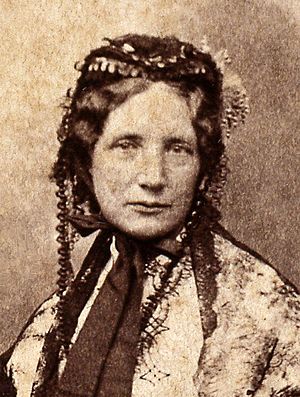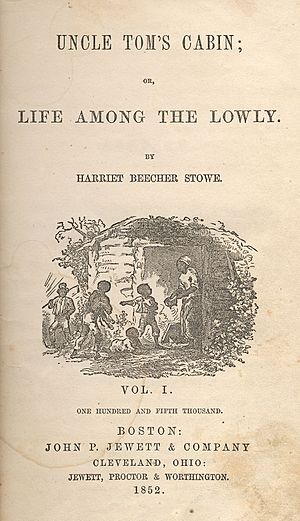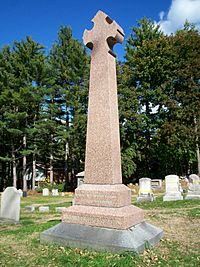Harriet Beecher Stowe facts for kids
Quick facts for kids
Harriet Beecher Stowe
|
|
|---|---|

Stowe circa 1852
|
|
| Born | Harriet Elisabeth Beecher June 14, 1811 Litchfield, Connecticut, United States |
| Died | July 1, 1896 (aged 85) Hartford, Connecticut, United States |
| Pen name | Christopher Crowfield |
| Spouse | Calvin Ellis Stowe |
| Signature | |
Harriet Beecher Stowe (born June 14, 1811 – died July 1, 1896) was an American writer and a strong supporter of ending slavery. She is famous for her novel Uncle Tom's Cabin, published in 1852. This book showed the difficult lives of African-American people who were enslaved.
Uncle Tom's Cabin became very popular as both a book and a play. It had a huge impact in the United States and Britain. The book helped many people understand the cruelty of slavery and encouraged them to speak out against it.
Contents
Harriet's Early Life and Family
Harriet Elisabeth Beecher was born in Litchfield, Connecticut, on June 14, 1811. Her parents were Lyman Beecher and Roxana (Foote) Beecher. Her father was a well-known religious leader. Harriet's mother passed away when Harriet was only five years old.
She had several siblings who also became famous. Her sister, Catharine Beecher, was an educator and writer. Her brothers, Henry Ward Beecher, Charles Beecher, and Edward Beecher, were also important figures.
Harriet went to a school for girls run by her sister Catharine. There, she studied many subjects, including languages and mathematics. When she was 21, she moved to Cincinnati, Ohio, to live with her father. He had become the president of a school called Lane Theological Seminary.
Marriage and Views on Slavery
On January 6, 1836, Harriet married Calvin Ellis Stowe. He was a professor at the seminary and had lost his first wife. They had seven children together, including twin daughters.
Calvin Stowe was also against slavery. Harriet and Calvin supported the Underground Railroad. This was a secret network that helped enslaved people escape to freedom. They even hid some people escaping slavery in their own home for a short time.
Uncle Tom's Cabin and Its Impact
In 1850, Harriet and her family moved to Brunswick, Maine. Her husband was teaching at Bowdoin College there. Harriet decided to write a story about slavery.
In June 1851, the first part of her book, Uncle Tom's Cabin, was published in an anti-slavery newspaper called the National Era. It was published in weekly parts until April 1852.
The full book was released on March 20, 1852. It quickly became incredibly popular. In less than a year, 300,000 copies were sold! This was a huge number for that time.
The book made Americans think deeply about slavery. It caused many debates and made more people want to end slavery. People in the Southern states, where slavery was common, strongly disliked the book.
Meeting President Lincoln
After the American Civil War began, Harriet Beecher Stowe visited Washington, D.C.. She met President Abraham Lincoln on November 25, 1862.
Harriet's daughter, Hattie, later said their visit to the White House was "very funny." Lincoln reportedly greeted Stowe by saying, "So this is the little lady who made this big war." This shows how much impact her book had on the country. Harriet herself wrote to her husband that she had a "real funny interview with the President."
Harriet's Later Life and Death
Harriet Beecher Stowe passed away on July 1, 1896, in Hartford, Connecticut. She is buried in the cemetery at Phillips Academy in Andover, Massachusetts.
Harriet's Lasting Legacy

Harriet Beecher Stowe is remembered in many ways. Several places are dedicated to her memory across the United States, including in Ohio, Florida, Maine, and Connecticut. These places show different parts of her life.
Important Places in Harriet's Life
Cincinnati, Ohio
The Harriet Beecher Stowe House in Cincinnati, Ohio, was once her father's home. Harriet lived here before she got married. This house is now a historical site open to the public. It teaches visitors about Harriet Beecher Stowe, the Lane Seminary, and the Underground Railroad. It also shares important African-American history.
Mandarin, Florida
In the 1870s and 1880s, Stowe and her family spent their winters in Mandarin, Florida. This area is now part of Jacksonville. While living there, Stowe wrote a book called Palmetto Leaves in 1873. This book described Northeast Florida and its people.
Stowe helped Florida grow after the Civil War. She helped start a church and a school. She also encouraged growing oranges, which became a major crop in the state. The school she helped create in 1870 was special because it was for both Black and white children and adults. This was very unusual for the time.
Brunswick, Maine
The Harriet Beecher Stowe House in Brunswick, Maine, is where Stowe lived when she wrote Uncle Tom's Cabin. Her husband taught at nearby Bowdoin College. Harriet often invited students and friends to her home to read and discuss parts of her book before it was published. This house is now open to the public.
Hartford, Connecticut
The Harriet Beecher Stowe House in Hartford, Connecticut, was Harriet's home for the last 23 years of her life. It was right next door to the house of another famous author, Mark Twain. This house has many of Stowe's original belongings and items from her time. It is open for tours.
Washington, Kentucky
In 1833, when Stowe was in Cincinnati, there was a serious illness called cholera. To stay safe, Stowe visited Washington, Kentucky. While there, she was taken to see a slave auction in nearby Maysville. Scholars believe this experience deeply affected her and influenced her writing.
Uncle Tom's Cabin Historic Site
The Uncle Tom's Cabin Historic Site is in Dresden, Ontario, Canada. It is part of a restored community for freed slaves called the Dawn Settlement. This community was founded by Reverend Josiah Henson and other people who were against slavery. Josiah Henson and the Dawn Settlement helped inspire Stowe to write Uncle Tom's Cabin.
Honors and Recognition
- Harriet Beecher Stowe is honored on July 1 in the liturgical calendar of the Episcopal Church (USA).
- In 2007, the United States Postal Service released a special postage stamp in her honor.
Images for kids
See also
 In Spanish: Harriet Beecher Stowe para niños
In Spanish: Harriet Beecher Stowe para niños






